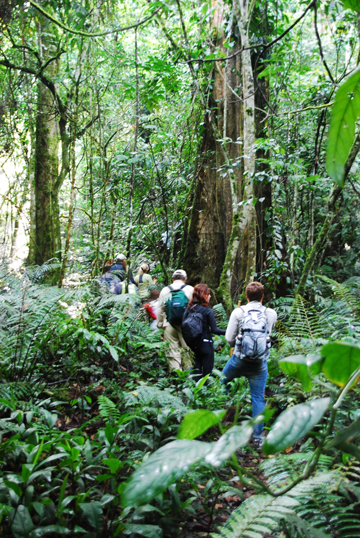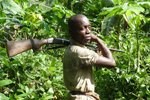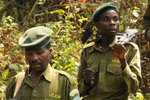The sunlight poured through the canopy, casting dappled shade over Makara, a large silverback mountain gorilla, as he cast his eyes around the forest clearing, checking on the members of his harem. A female gorilla reclined on a bank of dense vegetation of the most brilliant green, clutching her three day old infant close to her chest, and elsewhere, two juvenile gorillas played around a small tree, running rings around it until one crashed into the other and they rolled themselves into a roly-poly ball of jet black fluff that came to a halt a few meters in front of our delighted group.
I was part of a select few tourists permitted to visit this particular gorilla family, known as the Habinyanja group, whilst on safari in Bwindi Impenetrable National Park in Uganda. Gorilla trekking in Uganda and Rwanda has rapidly become one of life’s ‘bucket list’ wildlife encounters. It is also become the key to the survival of the species—as long as it is conducted responsibly. Gorilla tourism has helped mountain gorillas (Gorilla beringei beringe) make a successful comeback from the very brink of extinction. By the mid to late 1970s, their population plummeted to less than 400 individuals across their last surviving habitats in Rwanda, Uganda and what was then Zaire (now the Democratic Republic of Congo). Increased interest in their conservation, coupled with the advent of gorilla tourism in the 1980s and 90s, populations increased steadily. Last year, the results of recent census studies confirmed the total population for mountain gorillas was now at 880 individuals, split across the two distinct locations of Bwindi Impenetrable National Park and the Virunga Volcanoes, the latter comprising three different conservation areas across Rwanda, DRC and Uganda.
Gorilla trekking has not only become a vital conservation fund-raising tool—in Uganda, gorilla tourism contributes approximately 80% of the national wildlife authority’s overall budget, thereby financing the bulk of wildlife and habitat conservation across the country as a whole—but it has also turned the gorillas into a valuable commodity prized by local communities and government alike. These gentle giants provide much-needed funding for local infrastructure and a source of employment on both a local and national level, as well as playing a catalytic role in these countries’ nascent tourism industries. While a typical gorilla tourist’s main objective is to encounter the gorilla, they end up visiting other parks and attractions in the region as well. Tourism has become a major player—according to the Rwanda Development Board revenues have almost doubled in the last five years and tourism now accounts for 7.8% of Rwanda’s GDP and growing. The World Wildlife Fund has recently estimated that each gorilla brings in USD $1 million in revenue each year for Uganda. On the very simple premise that nobody likes to kill a cash cow, this alone appears to bode well for their survival.

Silverback mountain gorilla. Photo by: Nick Hoggett.
Despite this, it does seem that hunters’ snares are ever present. Poachers are not always after the gorillas themselves, as most snares are laid as part of the illegal poaching of smaller game such as duikers—dainty little forest antelopes. Tragically though, inquisitive young gorillas often find themselves caught in snares intended for another species. In the first few weeks of 2013, the Gorilla Doctors, a veterinary team providing the gorillas with medical care in Rwanda, Uganda and DRC, performed four medical interventions on gorillas trapped in snares. One intervention was for a juvenile male gorilla called Kajeyo from the very group I had visited—the group’s trackers had noticed the snare wrapped around the young gorilla’s arm when they visited the group with tourists the day before. The operation on Kajeyo went well, but not all gorillas survive snare injuries—and with around 1,200 snares found and destroyed in Volcanoes National Park in Rwanda last year alone, it remains a very real threat.
Political instability is another factor. Uganda and Rwanda may have experienced steady growth in tourism once they were able to put their respective troubled pasts behind them—but the DRC has not been so lucky. Violent conflict in the eastern regions of the Congo is impacting the ongoing conservation of their gorillas.
According to Jessica Burbridge, of the Gorilla Doctors, since the M23 rebels have moved into the area inhabited by the apes on the Congolese side of the border, “Insecurity in Eastern DRC has limited our ability to monitor and treat gorillas in Virunga National Park.”
 Trekking for mountain gorillas. Photo by: Anne-Marie Weeden. |
Ironically, health risks to the gorillas have increased with the growth of gorilla tourism. Sharing 98% of our human DNA, mountain gorillas are very susceptible to contracting human illnesses. Strict ‘gorilla etiquette’ rules apply when tracking, including observing a minimum distance of 7 meters and preventing anyone from tracking if they have a cold or other transmittable disease. Nevertheless, it is not unheard of for gorillas to break the rules themselves, and approach human visitors. Sometimes rangers will advise you to step back, and sometimes there is little you can do to avoid contact. Let’s face it—if a two hundred pound silverback decides he wants to ruffle your hair, there is little you or anyone else can do about it.
It happened to one of our clients, in a chance encounter with a gorilla group passing through the gardens of his lodge. His experience was captured on video and used to promote African Wildlife Foundation, one of the major long term supporters of gorilla conservation, yet the inadvertent close contact seen in the film initially raised a few eyebrows in conservation circles.
The truth is, whilst Gorilla Doctors have identified the cause of death for some gorillas as infections that have originated as human viruses, they have not been able to say whether these came from the local community or visiting tourists. Equally, gorillas also have their own viruses and bacteria. Currently, the team is collecting samples from the Sabyinyo group in Rwanda, who recently suffered a serious outbreak of respiratory illness. They may never ascertain the origin of this particular family’s problems, but there is an ongoing debate about whether tourists should don surgical masks when trekking gorillas in order to minimize the chance of passing on any contagious diseases.
Furthermore, it seems there is a surprising correlation between habituated gorillas (gorillas that have learned to accept the presence of humans) and faster rates of population growth. Gorilla Doctors have ascertained that the annual rate of growth for the habituated gorillas in the Virungas is more than five times that of the unhabituated gorillas in the same area. They attribute this pattern to the fact habituated gorillas can more easily benefit from ‘extreme conservation’ practices such as medical intervention. Simply put, completely wild gorillas are harder to treat when they develop illnesses, injure each other, or get trapped in snares. So while habituated gorillas may be more vulnerable to human illnesses, the net result of their habituation is having a greater chance of healthy population growth.
.600.jpg)
Baby mountain gorilla. Photo by: Nick Hoggett.
But the long term survival of the species is not (if you’ll pardon the pun) out of the woods yet. According to Alastair McNeilage of the Wildlife Conservation Society, the population of 400 gorillas in Uganda is still critically small, “Bwindi is one of the best protected national parks across Africa but it’s a very small island of isolated forest surrounded by some of the highest rural human population densities in Africa. Most scientists would say that a minimum population of 500 breeding individuals is needed to be sure of their long term viability.” Even though recent census results do paint a positive picture, the long term future is still very uncertain.
McNeilage believes the impact of climate change could have devastating effects, as farmers seek land at increasingly higher altitudes. Current estimates indicate that by the end of the century, growing conditions for a particular crop will have risen around 700 meters in altitude, so there is likely to be plenty of demand for land higher up the mountainous slopes of Bwindi or the Virungas. He is a firm supporter of gorilla tourism, highlighting the importance of nurturing sustainable, high-end tourism in order to justify maintaining these areas as forest habitats for the gorillas.
The survival of the mountain gorilla, as both a critically endangered species with which we share a very special kinship, and as a significant pillar of the local and national economies, is increasingly important. It is naïve to think the challenges that these gentle giants face will disappear—indeed they have arguably multiplied in scale and number since gorilla conservation began—but responsible gorilla tourism, that benefits both the wildlife and the communities that surround it, could be the very salvation of this incredible species.
The author would like to thank the Rwanda Development Board, Gorilla Doctors, Alastair McNeilage of the Wildlife Conservation Society and Professor Wilber Ahebwa of Makerere University in Uganda, for their help and support when writing this article.
About the Author: Anne-Marie Weeden first fell in love with Africa when she drove a small pink 2wd van all the way across the Sahara for charity. After years of taking every opportunity she could to travel the continent, she left the ‘day job’ in London to move to Uganda with her partner, where she has tracked gorillas, darted rhinos, hand-fed giraffe and learned how to speak chimp. She now works for Journeys Discovering Africa, helping to provide tailor-made wildlife safaris to East Africa, including gorilla trekking tours in Uganda and Rwanda.

Visiting the mountain gorillas. Photo by: Nick Hoggett.
.600.jpg)
Mountain gorilla. Photo by: Anne-Marie Weeden.
Related articles
Gorilla paradise: new park safeguards 15,000 western lowland gorillas
(01/31/2013) In 2008 the Wildlife Conservation Society (WCS) announced a jaw-dropping discovery: remote swamp forests in northern Republic of Congo contained a stunning population of 125,000 western lowland gorillas that had somehow gone unnoticed by scientists. At the time the President of WCS, Steven E. Sanderson, called the area the “mother lode of gorillas,” and expressed hope that the discovery would lead to a new park. Well, late last year, a park was finalized.
Mountain gorilla population up by over 20 percent in five years
(11/13/2012) A mountain gorilla census in Uganda’s Bwindi Impenetrable National Park has a population that continues to rise, hitting 400 animals. The new census in Bwindi means the total population of mountain gorillas (Gorilla beringei beringei) has reached 880—up from 720 in 2007—and marking a growth of about 4 percent per year.
NASA satellites catch vast deforestation inside Virunga National Park
(10/03/2012) Two satellite images by NASA, one from February 13, 1999 and the other from September 1, 2008 (see below), show that Virunga National Park is under assault from deforestation. Located in the eastern edge of the Democratic Republic of Congo (DRC) the park has been assailed by entrenched conflict between rebels and government forces, as well as slash-and-burn farming, the charcoal trade, and a booming human population.
British government comes out against drilling in Virunga National Park by UK company
(10/01/2012) The British government has come out in opposition against oil drilling plans by UK-based, SOCO International, in Virunga National Park, reports Reuters. The first national park established on the continent, Virunga is home to one of only two populations of mountain gorillas (Gorilla beringei beringei) in the world. In March of this year, two oil exploratory permits came to light granting SOCO seismic testing inside the park by the government of the Democratic Republic of Congo (DRC).
Rarest gorillas lose half their habitat in 20 years
(10/01/2012) Cross River gorillas and eastern gorillas lost more than half their habitat since the early 1990s due to deforestation, logging, and other human activities, finds a comprehensive new assessment across great apes’ range in West and Central Africa.
Turning gorilla poachers into conservationists in the Congo [warning: graphic photos]

(08/13/2012) Although founded only four years ago, Endangered Species International-Congo, has ambitious plans to protect dwindling Western gorilla populations and aid local people in the Republic of the Congo. The organization, an offshoot of Endangered Species International (ESI), has been spending the last few years studying the bushmeat trade in Pointe-Noire, the country’s second largest city, and developing plans for turning hunters into conservationists.
First camera trap video of world’s rarest gorilla includes shocking charge
(05/08/2012) Ever wonder what it would be like to be charged by a male gorilla? A new video (below) released by the Wildlife Conservation Society (WCS), gives one a first hand look. Shot in Cameroon’s Kagwene Gorilla Sanctuary, the video is the first camera trap footage of the incredibly rare Cross River gorilla subspecies (Gorilla gorilla diehli); listed as Critically Endangered, the subspecies is believed to be down to only 250 individuals.
(05/02/2012) A new study confirms that bigger and stronger silverback gorillas have more success finding mates and raising offspring.
Oil exploration approved in Africa’s oldest park, Virunga National Park
(03/19/2012) Permits for controversial oil exploration in Virunga National Park have been released after request by NGO Global Witness. Oil company, SOCO International, has confirmed it has received two permits to undertake preliminary exploration, including seismic tests, in the UNESCO World Heritage Site. Located in the Democratic Republic of Congo (DRC), Virunga is famous for its population of the Critically Endangered mountain gorillas (Gorilla beringei beringei).
Without data, fate of great apes unknown

(03/12/2012) Our closest nonhuman relatives, the great apes, are in mortal danger. Every one of the six great ape species is endangered, and without more effective conservation measures, they may be extinct in the wild within a human generation. The four African great ape species (bonobos, chimpanzees and two species of gorilla) inhabit a broad swath of land across the middle of Africa, and two species of orangutans live in rainforests on the islands of Borneo and Sumatra in Southeast Asia.